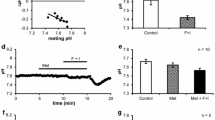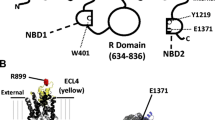Abstract
The activities of cystic fibrosis transmembrane conductance regulator (CFTR) Cl− channel and the amiloride-sensitive epithelial Na+ channel (ENaC) are acutely coordinated in the sweat duct. However, the mechanisms responsible for cross-talk between these ion channels are unknown. Previous studies indicated that luminal pH of sweat ducts varies over 3 pH units and that the cytoplasmic pH affects both CFTR and ENaC. Therefore, using basolaterally α-toxin-permeabilized apical membrane preparations of sweat ducts as an experimental system, we tested the hypothesis that the cytosolic pH may mediate the cross-talk between CFTR and ENaC. We showed that while luminal pH had no effect, cytosolic pH acutely affected ENaC activity. That is, acidic pH inhibited, while basic pH activated, ENaC. pH regulation of ENaC appears to be independent of CFTR or endogenous kinase activities because basic pH independently stimulated ENaC (1) in normal ducts even when CFTR was deactivated, (2) in CF ducts that lack CFTR in the plasma membranes and (3) after blocking endogenous kinase activity with staurosporine. Considering the evidence of Na+/H+ exchange (NHE) activity as shown by the expression of mRNA and function of NHE in the basolateral membrane of the sweat duct, we postulate that changes in cytosolic Na+ ([Na+] i ) may alter cytosolic pH (pH i ) as salt loads into the cell during electrolyte absorption. These changes may play a role in coordinating the activities of ENaC and CFTR during transepithelial salt transport.










Similar content being viewed by others
References
Awayda MS, Boudreaux MJ, Reger RL, Hamm LL (2000) Regulation of the epithelial Na+ channel by extracellular acidification. Am J Physiol 279:C1896–C1905
Benos DJ, Awayda MS, Ismailov II, Johnson JP (1995) Structure and function of amiloride-sensitive Na+ channels. J Membr Biol 143:1–18
Berdiev BK, Shlyonsky VG, Senyk O, Keeton D, Guo Y, Matalon S, Cantiello HF, Prat AG, Ausiello DA, Ismailov II, Benos DJ (1997) Protein kinase a phosphorylation and G protein regulation of type II pneumocyte Na+ channels in lipid bilayers. Am J Physiol 272:C1262–C1270
Bijman J, Quinton PM (1987) Lactate and bicarbonate uptake in the sweat duct of cystic fibrosis and normal subjects. Pediatr Res 21:79–82
Boucher RC (2001) Pathogenesis of cystic fibrosis airways disease. Trans Am Clin Climatol Assoc 112:99–107
Boucher RC, Chinet T, Willumsen N, Knowles MR, Stutts MJ (1991) Ion transport in normal and CF airway epithelia. Adv Exp Med Biol 290:105–115
Bubien JK, Watson B, Khan MA, Langloh AL, Fuller CM, Berdiev B, Tousson A, Benos DJ (2001) Expression and regulation of normal and polymorphic epithelial sodium channel by human lymphocytes. J Biol Chem 276:8557–8566
Butterworth MB, Edinger RS, Johnson JP, Frizzell RA (2005a) Acute ENaC stimulation by cAMP in a kidney cell line is mediated by exocytic insertion from a recycling channel pool. J Gen Physiol 125:81–101
Butterworth MB, Frizzell RA, Johnson JP, Peters KW, Edinger RS (2005b) PKA-dependent ENaC trafficking requires the SNARE-binding protein complexin. Am J Physiol 289:F969–F977
Canessa CM, Schild L, Buell G, Thorens B, Gautschi I, Horisberger JD, Rossier BC (1994) Amiloride-sensitive epithelial Na+ channel is made of three homologous subunits. Nature 367:463–467
Chalfant ML, Denton JS, Berdiev BK, Ismailov II, Benos DJ, Stanton BA (1999) Intracellular H+ regulates the α-subunit of ENaC, the epithelial Na+ channel. Am J Physiol 276:C477–C486
Cook DL, Ikeuchi M, Fujimoto WY (1984) Lowering of pH i inhibits Ca2+-activated K+ channels in pancreatic B-cells. Nature 311:269–271
Cuppoletti J, Baker AM, Malinowska DH (1993) Cl− channels of gastric parietal cells that are active at low pH. Am J Physiol 264:C1609–C1618
Duffey ME, Devor DC (1990) Intracellular pH and membrane potassium conductance in rabbit distal colon. Am J Physiol 258:C336–C343
Eaton DC, Hamilton KL, Johnson KE (1984) Intracellular acidosis blocks the basolateral Na-K pump in rabbit urinary bladder. Am J Physiol 247:F946–F954
Garty H, Civan ED, Civan MM (1985) Effects of internal and external pH on amiloride-blockable Na+ transport across toad urinary bladder vesicles. J Membr Biol 87:67–75
Garty H, Palmer LG (1997) Epithelial sodium channels: function, structure, and regulation. Physiol Rev 77:359–396
Granger D, Marsolais M, Burry J, Laprade R (2003) Na+/H+ exchangers in the human eccrine sweat duct. Am J Physiol 285:C1047–C1058
Greger R (1981) Cation selectivity of the isolated perfused cortical thick ascending limb of Henle’s loop of rabbit kidney. Pfluegers Arch 390:30–37
Harvey BJ, Thomas SR, Ehrenfeld J (1988) Intracellular pH controls cell membrane Na+ and K+ conductances and transport in frog skin epithelium. J Gen Physiol 92:767–791
Helman SI, Grantham JJ, Burg MB (1971) Effect of vasopressin on electrical resistance of renal cortical collecting tubules. Am J Physiol 220:1825–1832
Hwang TC, Nagel G, Nairn AC, Gadsby DC (1994) Regulation of the gating of cystic fibrosis transmembrane conductance regulator C1 channels by phosphorylation and ATP hydrolysis. Proc Natl Acad Sci USA 91:4698–4702
Ismailov II, Berdiev BK, Shlyonsky VG, Fuller CM, Prat AG, Jovov B, Cantiello HF, Ausiello DA, Benos DJ (1997) Role of actin in regulation of epithelial sodium channels by CFTR. Am J Physiol 272:C1077–C1086
Komwatana P, Dinudom A, Young JA, Cook DI (1996) Cytosolic Na+ controls an epithelial Na+ channel via the Go guanine nucleotide-binding regulatory protein. Proc Natl Acad Sci USA 93:8107–8111
Leaf A, Keller A, Dempsey EF (1964) Stimulation of sodium transport in toad bladder by acidification of mucosal medium. Am J Physiol 207:547–552
Lingueglia E, de Weille JR, Bassilana F, Heurteaux C, Sakai H, Waldmann R, Lazdunski M (1997) A modulatory subunit of acid sensing ion channels in brain and dorsal root ganglion cells. J Biol Chem 272:29778–29783
Lingueglia E, Voilley N, Waldmann R, Lazdunski M, Barbry P (1993) Expression cloning of an epithelial amiloride-sensitive Na+ channel. A new channel type with homologies to Caenorhabditis elegans degenerins. FEBS Lett 318:95–99
Lyall V, Feldman GM, Biber TU (1995) Regulation of apical Na+ conductive transport in epithelia by pH. Biochim Biophys Acta 1241:31–44
Palmer LG (1985) Modulation of apical Na permeability of the toad urinary bladder by intracellular Na, Ca, and H. J Membr Biol 83:57–69
Quinton PM (1999) Physiological basis of cystic fibrosis: a historical perspective. Physiol Rev 79:S3–S22
Quinton PM, Reddy MM (1992) Control of CFTR chloride conductance by ATP levels through non-hydrolytic binding. Nature 360:79–81
Reddy MM, Kopito RR, Quinton PM (1998) Cytosolic pH regulates GCl through control of phosphorylation states of CFTR. Am J Physiol 275:C1040–C1047
Reddy MM, Light MJ, Quinton PM (1999) Activation of the epithelial Na+ channel (ENaC) requires CFTR Cl− channel function. Nature 402:301–304
Reddy MM, Quinton PM (1991) Intracellular potassium activity and the role of potassium in transepithelial salt transport in the human reabsorptive sweat duct. J Membr Biol 119:199–210
Reddy MM, Quinton PM (2005) ENaC activity requires CFTR channel function independently of phosphorylation in sweat duct. J Membr Biol 207:23–33
Reddy MM, Quinton PM (2006) Cytosolic potassium controls CFTR deactivation in human sweat duct. Am J Physiol 291:C122–C129
Reddy MM, Wang XF, Gottschalk M, Jones K, Quinton PM (2005) Normal CFTR activity and reversed skin potentials in pseudohypoaldosteronism. J Membr Biol 203:151–159
Schwiebert EM, Benos DJ, Egan ME, Stutts MJ, Guggino WB (1999) CFTR is a conductance regulator as well as a chloride channel. Physiol Rev 79:S145–S166
Snyder PM, McDonald FJ, Stokes JB, Welsh MJ (1994) Membrane topology of the amiloride-sensitive epithelial sodium channel. J Biol Chem 269:24379–24383
Stampe P, Vestergaard-Bogind B (1985) The Ca2+-sensitive K+-conductance of the human red cell membrane is strongly dependent on cellular pH. Biochim Biophys Acta 815:313–321
Stutts MJ, Canessa CM, Olsen JC, Hamrick M, Cohn JA, Rossier BC, Boucher RC (1995) CFTR as a cAMP-dependent regulator of sodium channels. Science 269:847–850
Stutts MJ, Rossier BC, Boucher RC (1997) Cystic fibrosis transmembrane conductance regulator inverts protein kinase A–mediated regulation of epithelial sodium channel single channel kinetics. J Biol Chem 272:14037–14040
Ussing HH, Zerahn K (1951) Active transport of sodium as the source of electric current in the short-circuited isolated frog skin. Acta Physiol Scand 23:110–127
Waldmann R, Bassilana F, de Weille J, Champigny G, Heurteaux C, Lazdunski M (1997a) Molecular cloning of a non-inactivating proton-gated Na+ channel specific for sensory neurons. J Biol Chem 272:20975–20978
Waldmann R, Champigny G, Bassilana F, Heurteaux C, Lazdunski M (1997b) A proton-gated cation channel involved in acid-sensing. Nature 386:173–177
Acknowledgments
The authors are grateful to Mr. Kirk Taylor for expert technical assistance and the numerous subjects who volunteered for skin biopsy. This study was funded by NIH-RO1 DE14352, NIH-RO1HL08042, USPHS R01 DK 51889 and the Nancy Olmsted Trust.
Author information
Authors and Affiliations
Corresponding author
Rights and permissions
About this article
Cite this article
Reddy, M.M., Wang, X.F. & Quinton, P.M. Effect of Cytosolic pH on Epithelial Na+ Channel in Normal and Cystic Fibrosis Sweat Ducts. J Membrane Biol 225, 1–11 (2008). https://doi.org/10.1007/s00232-008-9126-4
Received:
Accepted:
Published:
Issue Date:
DOI: https://doi.org/10.1007/s00232-008-9126-4




